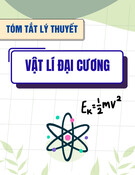
TNU Journal of Science and Technology
229(10): 173 - 180
http://jst.tnu.edu.vn 173 Email: jst@tnu.edu.vn
MANUFACTURE A DEVICE TO SURVEY E.M.F IN A COIL PLACED
IN THE MAGNETIC FIELD OF A MAGNET
Luu Thi Nhan*, Dao Van Thanh, Duong Vu Truong, Ngo Thi Hoa, Nguyen Van Hung, Nguyen Hung Minh
Hanoi University of Industry
ARTICLE INFO
ABSTRACT
Received:
08/4/2024
Electromagnetic induction is an important part of Physics knowledge taught
at most technology and engineering universities in Vietnam, including Hanoi
University of Industry. The survey shows that the number of experiments on
the phenomenon of electromagnetic induction taught at universities in Viet
Nam is almost non-existent or very small. Therefore, with the desire to
research and create a device of experiments on electromagnetic induction, the
authors conducted theoretical research combined with experimental research
to create device of experiments to survey electromotive force induction in a
coil placed in the magnetic field of a magnet. The results of investigating the
dependence of the induced electromotive force on the parameters: rotation
speed of the magnet, number of turns in wire coil, cross-section of the coil
show that: the amplitude Uout depends linearly on the rotation speed of the
magnet (coil with size d=42.44 mm, N=200 turns); the more turns of wire
coil, the larger Uout (coils with diameter d=51.9 mm and different numbers
of turns 50, 100, 200, 300) However, with the dependence of Uout on the
cross-sectional area of the coil, when increasing the cross-sectional area
Uout also increases, but increasing to 2114.48 mm2, Uout tends to decrease.
Especially when increasing to 4837.37 mm2, the decrease speed of Uout is
shown very clearly.
Revised:
10/6/2024
Published:
11/6/2024
KEYWORDS
Physics experiment
Electromagnetic induction
Electromotive force
Magnet
Coil
CHẾ TẠO BỘ THÍ NGHIỆM KHẢO SÁT SUẤT ĐIỆN ĐỘNG CẢM ỨNG
TRONG CUỘN DÂY ĐẶT TRONG TỪ TRƯỜNG CỦA NAM CHÂM
Lưu Thị Nhạn*, Đào Văn Thành, Dương Vũ Trường, Ngô Thị Hoa, Nguyễn Văn Hùng, Nguyễn Hùng Minh
Trường Đại học Công nghiệp Hà Nội
THÔNG TIN BÀI BÁO
TÓM TẮT
Ngày nhận bài:
08/4/2024
Hiện tượng cảm ứng điện từ là phần kiến thức Vật lý quan trọng được giảng
dạy trong hầu hết các trường Đại học công nghệ và kỹ thuật ở Việt Nam,
trong đó có Trường Đại học Công nghiệp Hà Nội. Qua khảo sát cho thấy, số
lượng bài thí nghiệm về hiện tượng cảm ứng điện từ được giảng dạy tại các
trường Đại học trong nước hầu như không có hoặc rất ít. Do đó với mong
muốn nghiên cứu xây dựng được bộ thí nghiệm về hiện tượng cảm ứng điện
từ, nhóm tác giả đã tiến hành nghiên cứu lý thuyết kết hợp nghiên cứu thực
nghiệm để chế tạo được bộ thí nghiệm khảo sát suất điện động cảm ứng trong
cuộn dây đặt trong từ trường của nam châm. Kết quả khảo sát sự phụ thuộc
của suất điện động cảm ứng cho thấy: biên độ của Ura phụ thuộc tuyến tính
vào tốc độ quay của nam châm (với cuộn dây có kích thước d=42,44 mm,
N=200 vòng); số vòng dây càng nhiều thì Ura càng lớn (với các cuộn dây có
đường kính d=51,9 mm và số vòng khác nhau 50, 100, 200, 300). Tuy nhiên
với sự phụ thuộc của Ura vào tiết diện của cuộn dây thì, khi tăng tiết diện Ura
cũng tăng, nhưng tăng tới 2114,48 mm2 thì Ura có xu hướng giảm. Đặc biệt
khi tăng tới 4837,37 mm2 tốc độ giảm của Ura được hiển thị rất rõ.
Ngày hoàn thiện:
10/6/2024
Ngày đăng:
11/6/2024
TỪ KHÓA
Thí nghiệm Vật lý
Cảm ứng điện từ
Suất điện động
Nam châm
Cuộn dây
DOI: https://doi.org/10.34238/tnu-jst.10069
* Corresponding author. Email: luu.nhan@haui.edu.vn

TNU Journal of Science and Technology
229(10): 173 - 180
http://jst.tnu.edu.vn 174 Email: jst@tnu.edu.vn
1. Giới thiệu
Trong dạy học nói chung và dạy học Vật lý nói riêng, thí nghiệm đóng một vai trò rất quan
trọng, vì vậy để nâng cao chất lượng dạy và học Vật lý ở trường Đại học trước hết phải tăng
cường việc sử dụng các thí nghiệm trong quá trình giảng dạy. Đó là lý do tại sao sự đổi mới trong
dạy học Vật lý luôn chú trọng vào việc nghiên cứu và xây dựng các thí nghiệm [1], [2].
Vai trò của hoạt động thí nghiệm trong dạy học ở những năm đầu của sinh viên bậc đại học
được phân tích rất rõ trong công trình nghiên cứu thuộc dự án “Project PL 95–2005” của nhóm
tác giả A. Tiberghien [3]. Nội dung nghiên cứu tập trung vào các vấn đề sau:
+ Đánh giá vai trò của các thí nghiệm trong các năm đầu ở đại học và nghiên cứu các hình
thức tổ chức làm thí nghiệm.
+ Thông qua các hoạt động về thí nghiệm của sinh viên sẽ giúp hình thành kỹ năng thực
nghiệm như quan sát, sử dụng các dụng cụ và thiết bị đo, biểu diễn kết quả đo, tính toán sai số...
+ Nâng cao kiến thức, thái độ và năng lực của sinh viên.
Trong những năm trở lại đây, nhiều nghiên cứu đã chỉ ra thí nghiệm Vật lý đóng một vai trò
hết sức quan trọng trong việc tạo ra và duy trì động cơ học tập của người học, đóng góp vào việc
nâng cao kiến thức của người học, giúp người học ghi nhớ và áp dụng các kiến thức lý thuyết,
nâng cao hiểu biết của người học, hình thành thế giới quan khoa học…[4], [5].
Với vai trò và tác dụng của thí nghiệm Vật lý trong đào tạo cũng như trong nghiên cứu khoa
học, hiện nay hầu hết các trường Đại học, Cao đẳng khối ngành kỹ thuật đều đưa thí nghiệm Vật lý
vào giảng dạy trong đó có nội dung về cảm ứng điện từ. Cảm ứng điện từ là một phần kiến thức rất
quan trọng được giảng dạy trong chương trình Vật lý vì có nhiều ứng dụng trong đời sống và kỹ
thuật. Trên thế giới cũng đã có nhiều nghiên cứu chế tạo thiết bị thí nghiệm Vật lý về hiện tượng
cảm ứng điện từ và đưa vào giảng dạy: Thí nghiệm về định luật cảm ứng Faraday [6], Nghiên cứu
hiện tượng cảm ứng điện từ và hiện tượng hỗ cảm sử dụng dao động ký [7], Xung điện áp (định luật
cảm ứng Faraday) [8]... Cũng có một số trường Đại học ở Việt Nam nhập các loại thiết bị từ nước
ngoài để đưa vào sử dụng trong giảng dạy và nghiên cứu. Nhìn chung, các thiết bị thí nghiệm Vật lý
này đều có chất lượng tốt, độ ổn định và chính xác cao tuy nhiên chúng có giá thành rất cao.
Qua tìm hiểu hệ thống thí nghiệm Vật lý về phần điện-từ tại 15 trường Đại học trong nước thì
nhận thấy có rất ít bài thí nghiệm về hiện tượng cảm ứng điện từ. Ngoài ra, nội dung trong các bài
thí nghiệm này có thể không phù hợp với nội dung giảng dạy Vật lý ở tất cả các trường Đại học ở
Việt Nam. Tại trường Đại học Công nghiệp Hà Nội, hiện nay chưa có bài thí nghiệm nào về hiện
tượng cảm ứng điện từ được sử dụng trong giảng dạy cho các học phần Vật lý. Do giới hạn về
chương trình đào tạo nên số lượng các bài thí nghiệm còn ít, nhiều bài thí nghiệm chưa thực sự
bám sát vào nội dung lý thuyết giảng dạy. Vì vậy việc chế tạo các bài thí nghiệm sát với chương
trình giảng dạy lý thuyết là vô cùng cần thiết, giúp sinh viên có thể kiểm chứng các kiến thức lý
thuyết đã học. Với mong muốn nghiên cứu và chế tạo ra những bài thí nghiệm Vật lý đáp ứng các
nội dung còn thiếu của phần thí nghiệm và hơn nữa là đáp ứng các mục tiêu đào tạo của môn học
chúng tôi đã tiến hành nghiên cứu và chế tạo bộ thiết bị khảo sát suất điện động cảm ứng trong
cuộn dây đặt trong từ trường của nam châm. Trong nghiên cứu này, nhóm đã chế tạo bộ thiết bị
và khảo sát sự phụ thuộc của suất điện động vào các thông số: tốc độ quay của nam châm, số
vòng dây, tiết diện của cuộn dây từ đó giúp người học có được cái nhìn tổng quan về lý thuyết và
thực nghiệm của hiện tượng cảm ứng điện từ.
2. Phương pháp nghiên cứu
Nhóm tác giả đã sử dụng nghiên cứu lý thuyết kết hợp nghiên cứu thực nghiệm. Cơ sở lý
thuyết của nghiên cứu này dựa vào các các định luật về hiện tượng cảm ứng điện từ, làm tiền đề
cho việc tính toán, lựa chọn các thông số để chế tạo bộ thí nghiệm. Sau khi thiết kế chế tạo bộ thí
nghiệm, nhóm tác giả tiến hành khảo sát sự phụ thuộc của suất điện động cảm ứng vào các thông
số: tốc độ quay của nam châm, số vòng dây, tiết diện của cuộn dây.

TNU Journal of Science and Technology
229(10): 173 - 180
http://jst.tnu.edu.vn 175 Email: jst@tnu.edu.vn
2.1. Cơ sở lý thuyết
Hiện tượng cảm ứng điện từ là hiện tượng xuất hiện suất điện động cảm ứng khi từ thông
trong mạch kín biến thiên gây ra. Giá trị của suất điện động cảm ứng
c
ξ
được xác định bởi biểu
thức sau:
m
cm
dΦ
ξ Φ t
dt
(1)
Từ thông
m
Φ
gửi qua một diện tích S bất kỳ là đại lượng vô hướng được xác định bởi:
mm
SS
Φ dΦ B.dS.cosα
(2)
Dễ dàng nhận thấy, từ thông phụ thuộc vào: cảm ứng từ B của từ trường, diện tích S mà từ
trường xuyên qua và góc α là góc tạo bởi vectơ pháp tuyến của diện tích S và vectơ cảm ứng từ B
của từ trường.
Như vậy khi cho từ thông trong mạch kín biến thiên thì từ công thức (1) sẽ xác định được suất
điện động cảm ứng xuất hiện trong mạch kín.
Một ứng dụng quan trọng của hiện tượng cảm ứng điện từ là tạo ra dòng điện xoay chiều.
Dưới đây là hai ví dụ điển hình.
Ví dụ 1 [9]: Một khung dây hình chữ nhật chứa N vòng dây có chiều dài a và chiều rộng b,
được quay với tần số f trong từ trường đều B như hình 1.
a. Chứng minh rằng suất điện động cảm ứng trên khung dây cho bởi công thức:
0
ξ 2πfNabBsin2πf ξ sin2πftt
.
b. Hãy thiết kế khung dây có thể cho được suất điện động
0
ξ =150V
khi nó quay với tần số
60,0 vòng/s trong từ trường 0,500T.
Hình 1. Hình vẽ minh họa cho ví dụ 1 [9]
Lời giải:
a. Hình 1 mô tả khung dây hình chữ nhật quay trong từ trường đều B. Khi khung dây quay
trong từ trường đều B thì từ thông gửi qua khung dây sẽ biến đổi theo biểu thức sau:
NBScos(ωt)
Khi đó trong khung dây sẽ xuất hiện suất điện động cảm ứng:
0
dΦ
ξ ωNBSsin ωt 2πfNBabsin 2πft ξ sin 2πft
dt
b. Để thiết kế khung dây có thể cho được suất điện động
0
ξ =150V
khi nó quay với tần số
60,0 vòng/s trong từ trường 0,500T, ta có:
2
00
ξ 2πfNBab Nab ξ 2πfB 150 2 .60.0,5 0,79m
Vậy phải thiết kế khung dây với số vòng sao cho diện tích:
2
Nab 0,79m
Ví dụ 2: Dynamo xe đạp
Dynamo ở xe đạp là một máy phát điện xoay chiều nhỏ, được sử dụng để tạo ra điện để thắp
sáng đèn xe đạp. Dynamo xe đạp cũng có thể được sử dụng để cung cấp điện cho các thiết bị điện
tử khác trên xe đạp, chẳng hạn như đèn báo rẽ, đèn phanh.
Cấu tạo của dynamo xe đạp gồm 3 bộ phận chính: cuộn dây, nam châm và núm quay. Ngoài
ra, dynamo xe đạp còn có một số bộ phận khác như vỏ bảo vệ, đèn báo hiệu (hình 2).

TNU Journal of Science and Technology
229(10): 173 - 180
http://jst.tnu.edu.vn 176 Email: jst@tnu.edu.vn
Nguyên lý hoạt động của dynamo trên xe đạp dựa trên hiện tượng cảm ứng điện từ. Khi bánh
xe quay, núm quay gắn với trục của cuộn dây cũng quay theo, do đó nam châm cũng quay theo.
Hình 2. Cấu tạo của dynamo xe đạp
Hình 3. Ảnh chụp bộ thí nghiệm sau khi lắp ráp
Nam châm quay trong cuộn dây dẫn điện, các đường sức từ của nam châm sẽ cắt qua cuộn
dây. Sự cắt qua của các đường sức từ sẽ tạo ra dòng điện cảm ứng trong cuộn dây. Dòng điện
cảm ứng này được truyền qua dây dẫn đến đèn xe đạp, làm đèn sáng.
Dòng điện cảm ứng tạo ra trong dynamo xe đạp là dòng điện xoay chiều. Dòng điện xoay chiều
này có tần số phụ thuộc vào tốc độ quay của nam châm. Tốc độ quay của nam châm càng lớn thì
cường độ dòng điện cảm ứng càng lớn. Ngoài ra cường độ dòng điện cảm ứng còn phụ thuộc vào
số vòng dây trong cuộn dây. Số vòng dây càng nhiều thì cường độ dòng điện cảm ứng càng lớn.
Trên cơ sở xem xét, tích hợp hai ví dụ ứng dụng điển hình của hiện tượng cảm ứng điện từ,
nhóm tác giả nhận thấy có thể chế tạo một bộ thí nghiệm khảo sát suất điện động cảm ứng trong
cuộn dây đặt trong từ trường của nam châm. Trong đó, chúng tôi sẽ đi khảo sát sự phụ thuộc của
suất điện động cảm ứng vào các thông số: tốc độ quay của nam châm, tiết diện của cuộn dây, số
vòng dây.
2.2. Thực nghiệm
Quy trình thiết kế bộ thí nghiệm được nhóm tác giả xây dựng tương tự các bước trong quy
trình [10]. Từ đó chúng tôi chế tạo được bộ thí nghiệm khảo sát suất điện động cảm ứng của cuộn
dây đặt trong từ trường của nam châm. Bộ thí nghiệm bao gồm:
- Nam châm gắn với động cơ 775 DC12V.
- Bảng điện gắn ngoài gồm bóng đèn 6V-2,4W và các dây nối.
- Hệ thống giá đỡ để điều chỉnh và ghi nhận tốc độ quay của nam châm.
Nam châm được chúng tôi lựa chọn nghiên cứu là nam châm thẳng có kích thước 40x10x10.
Các vòng dây được quấn với kích thước khác nhau gồm: 1 cuộn dây được quấn 200 vòng quanh
lõi với đường kính lõi 42,44 mm. 4 cuộn dây khác nhau có cùng đường kính lõi là 51,9 mm được
quấn với số vòng lần lượt là 50 vòng, 100 vòng, 200 vòng, 300 vòng. 5 cuộn dây khác nhau cùng
được quấn 200 vòng quanh các lõi khác nhau với đường kính lần lượt là 38 mm, 42,44 mm, 51,9
mm, 63,44 mm, 78,50 mm.
Để cung cấp nguồn cho động cơ quay chúng tôi sử dụng nguồn Adapter điều chỉnh DC3-12V 5A.
Để đo tốc độ quay của nam châm chúng tôi sử dụng đồng hồ đo tốc độ quay không tiếp xúc
Extech.
Để đo biên độ Ura, Ira chúng tôi sử dụng 2 đồng hồ đo điện đa năng hiện số hiệu Victor
VC890D.
Các phép đo được thực hiện tại bộ môn Vật lý khoa Khoa học cơ bản Trường Đại học Công
nghiệp Hà Nội.

TNU Journal of Science and Technology
229(10): 173 - 180
http://jst.tnu.edu.vn 177 Email: jst@tnu.edu.vn
Bộ thí nghiệm sau khi lắp ráp hoàn chỉnh có trong hình 3, gồm: 1 - hệ khung giá đỡ, 2 - động
cơ DC 775, 3 - máy đo tốc độ quay, 4 - nam châm hình trụ, 5 - cuộn dây, 6 - bóng đèn, 7 - hộp
bảng điện, 8 - nguồn DC 3- 12V 5A, 9 - Ampe kế, 10 - Vôn kế.
3. Kết quả và thảo luận
3.1. Khảo sát sự phụ thuộc của Ura, Ira vào tốc độ quay của nam châm
Tiến hành khảo sát sự phụ thuộc của biên độ Ura, Ira vào tốc độ quay của nam châm chúng tôi
gắn cuộn dây với kích thước d = 42,44 mm, N=200 vòng dây vào trục của giá đỡ. Sau đó vặn
núm điều chỉnh của nguồn Adapter và chọn một giá trị Uvào nhất định, đồng thời quan sát tốc độ
quay của nam châm qua đồng hồ Extech. Để đo giá trị Ura, Ira chúng tôi quan sát đồng hồ đo điện
đa năng hiện số hiệu Victor và ghi lại kết quả. Lặp lại phép đo 5 lần đối với mỗi giá trị Uvào đã
chọn. Kết quả thu được theo Bảng 1.
Bảng 1. Kết quả sự phụ thuộc của Ura, Ira vào tốc độ quay ω
Uvào(V)
ω(vòng/phút)
Ira(mA)
Ura(V)
Uvào(V)
ω(vòng/phút)
Ira(mA)
Ura(V)
3,94
818
34,1
0,076
7,89
2450
86
0,280
816
33,9
0,076
2450
85,8
0,278
818
34,4
0,076
2452
86,0
0,280
819
34,2
0,076
2458
86,2
0,280
819
34,4
0,077
2447
85,9
0,280
4,49
1060
43,9
0,101
9,04
2810
92,3
0,344
1063
44,2
0,102
2818
92,1
0,348
1066
44,3
0,101
2814
92,2
0,346
1068
44,5
0,102
2816
92,4
0,346
1063
43,8
0,101
2813
92,5
0,345
5,04
1347
54,6
0,131
10,1
3085
93,3
0,404
1343
54,8
0,130
3083
93,1
0,415
1344
54,8
0,131
3083
93,4
0,412
1350
54,9
0,131
3084
93,5
0,413
1347
54,7
0,131
3084
93,4
0,414
5,92
1666
65,6
0,168
10,9
3270
96,0
0,451
1668
65,9
0,168
3269
95,7
0,453
1669
65,9
0,168
3274
95,5
0,455
1669
66,0
0,168
3274
96,4
0,451
1671
65,9
0,168
3272
96,7
0,451
6,90
2053
76,7
0,219
11,9
3435
98,7
0,483
2050
76,9
0,219
3434
98,6
0,483
2052
77,1
0,219
3437
99,8
0,478
2053
77,1
0,219
3436
99,5
0,479
2049
76,8
0,219
3438
98,5
0,486
Từ Bảng 1, tính giá trị trung bình của các đại lượng và thu được kết quả phép đo theo Bảng 2.
Bảng 2. Kết quả đo biên độ Ura, Ira theo tốc độ quay ω
STT
ω
(vòng/phút)
I I(mA)
ra
δ%(I)
(gồm cả sai số của dụng
cụ và sai số ngẫu nhiên)
U U(V)
ra
δ%(U)
(gồm cả sai số của
dụng cụ và sai số
ngẫu nhiên)
1
818,0
34,2±0,160
3,15
0,076±0,0003
5,16
2
1064,0
44,14±0,232
3,0
0,101±0,0005
4,23
3
1346,2
54,76±0,088
2,51
0,131±0,0003
3,34
4
1668,6
65,86±0,104
2,41
0,168±0
2,59



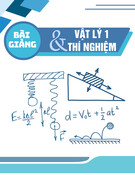

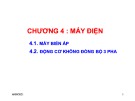

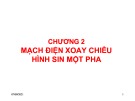

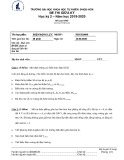

![Bộ câu hỏi lý thuyết Vật lý đại cương 2 [chuẩn nhất/mới nhất]](https://cdn.tailieu.vn/images/document/thumbnail/2025/20251003/kimphuong1001/135x160/74511759476041.jpg)
![Bài giảng Vật lý đại cương Chương 4 Học viện Kỹ thuật mật mã [Chuẩn SEO]](https://cdn.tailieu.vn/images/document/thumbnail/2025/20250925/kimphuong1001/135x160/46461758790667.jpg)




